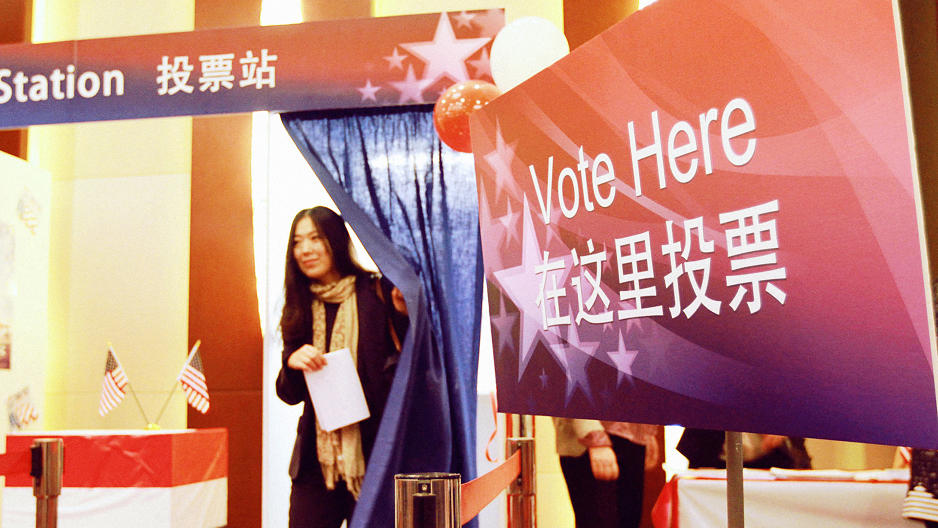4 Ideas For Redesigning How We Vote
Just press a button on your phone if you want pizza delivery, groceries, a massage, or to speak to a therapist without ever leaving home. But if you want to vote in the upcoming election, and you’re not voting in Alaska or via an absentee ballot, you’ll still need to get up and walk or drive to a polling place.
So why can’t we yet vote online? After all, the mechanics of voting on the internet are relatively simple—and many states already offer online voting for some voters. The most common argument against online voting for everyone have long been potential security and privacy vulnerabilities, which are more difficult challenges.
Though these may be valid concerns, the fact that you still can’t vote online in the U.S. in 2016 is really depressing, considering that the internet is today’s primary tool of engagement and that it could be used to make voting an easier, cooler, and better-informed pursuit. Voting could use the help: Less than 30% of eligible voters cast a ballot in the presidential primaries. That’s the second-highest turnout since 1980, and it’s not great. Even fewer people show up to vote in elections that don’t involve a presidential race.
Now consider Facebook’s recent impact on voter registration: Last month, when the social network posted a tiny message on its users’ news feeds that linked to websites enabling them to register, voter registration increased so dramatically that nine state election administrators felt compelled to comment on it. The nonprofit Center for Election Innovation & Research looked at 16 states’ voter registration data and found that almost all of them saw a “massive increase” in registration activity on the day that Facebook’s reminder message went live.
Most experts agree that online voting for everyone is not happening in the U.S. anytime soon (though it’s already happening in places like Canada and Estonia).
But imagine if a company like Facebook could do something similar to what it has done with voter registration on Election Day. Or even better, if the same designers who figure out how to get us to watch more cat videos could also figure out how to help us understand our ballots. Yes, there would still be some serious questions about protecting such a system. But if we figured them out, redesigning our voting system could have a significant impact on voter turnout.
To brainstorm ideas, I asked a handful of entrepreneurs who think about voting engagement. Setting aside security and political considerations, here’s what they came up with.
Use The Blockchain To Secure Votes
Whose idea is this? Luke Davis, who founded Placeavote, which encourages people to vote on bills in Congress (the idea is to provide a new type of polling data representatives can use to make decisions).
How would it work? “You would publish votes to a blockchain, that way you can essentially keep the integrity of all voting records. [Blockchain is a data structure, best known for its use in the digital currency bitcoin, which creates a secure public record of transactions.] You could basically write your vote to this ledger however you wanted: on a mobile app, on a government site, on Facebook, on Google, as a plug-in. But you only get to write once to this ledger—it doesn’t matter who you write it with, but you only get to write it once. That vote counts.
“Because anyone can build a client on the blockchain ledger, all of these companies have incentive to participate and compete for the ad dollars of getting you to come to their product first for voting. When you logged into Facebook on voting day, Facebook would try to get you to place their vote with them. When you searched on Google, Google would try to get you to vote with them. And if you go on the internet when the time comes to vote, everyone is going to be slamming to get you to vote on their version.”
Use Push Alerts To Remind People To Vote
Whose idea is this? Tucker Bounds, who worked on campaigns for John McCain and Meg Whitman before landing at Facebook, which he recently left to cofound Sidewire, an app that aims to create a community for smart political discourse.
How would it work? “I would be able to download an app or visit a website where I can authenticate my identity and opt into prompts that remind me about upcoming elections. In addition, it would be nice if that process came with the ability to opt into voting in the traditional manner, but I still get the same prompts at my disposal.
“The reminder to vote on my phone and also the quick, easy access to the nonpartisan, state-delivered materials In the voter pamphlet—that alone would be extremely helpful for someone like myself who is running around and busy. It would be easy to get a push notification as a reminder that I can tap in and submit my ballot.”
Improve Identification Methods And Walk Voters Through The Ballot
Whose idea is this? Erika Reinhardt is a cofounder of VotePlz, a nonprofit that has been called an attempt at “TurboTax for voting.”
How would it work? “It’s interesting that absentee voting has already removed the [paper-trail record of votes], and they basically verify the identity of voters with signatures. And knowing they mailed you one ballot to your address and it has a barcode that came back.
“I will say signatures are not the greatest form of ID on the voter registration side. I feel like we could come up with something better. Maybe [the solution] is some sort of biometric scanning where you can do something on your phone, and you can confirm that you are actually you. Your pupil or your thumbprint is probably better [than a signature].
“Another current challenge in voting systems is, if you look at the down-ballot races, only about half of the people who vote for president will vote all the way down to their local school board elections. I think a lot of that is because it feels overwhelming to have to make decisions on all of those things, and maybe you don’t feel like you’re in a position to make that choice. What if there were something on your phone that would actually step you through all of these issues? You would take your time to clearly learn the pros and cons. That’s already in the pamphlet, but the pamphlet is not necessarily convenient to read. It would help guide people through. ‘You are now going to vote on local things. Local things are important because they impact you in these ways. Okay, proposition one. Here’s the information.’ Once you read the information, you have the option to decide whether to vote on it or not.”
Make Voter Registration Automatic
Whose idea is this? Matt Mahan is the CEO of Brigade, a political engagement network that just launched a social voting guide with more than 13,000 federal and state races and ballot propositions.
How does it work? “I think [improving voter turnout] starts with automatic registration, where when you become legally able to register, you are registered, and ideally that is tied into some supporting information and education for people. It’s automatic, like when you’re born, you just get a social security number assigned to you.
“When you turn 18 you are registered to vote, but then that’s supported through the school system and others to help you understand the power you have and how to use it. I think that voter registration has to follow you around, and it should be tied to things like a mailing address or a drivers license. So as you change your mailing address at the post office or your drivers license at the DMV, the system is smart and automatically offers to move your registration with you.”
Fast Company , Read Full Story
(21)














